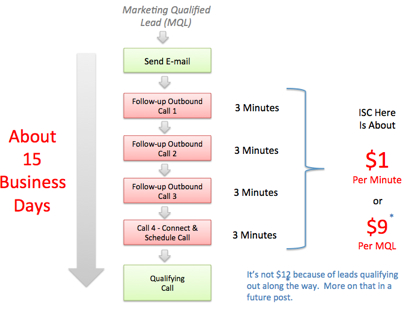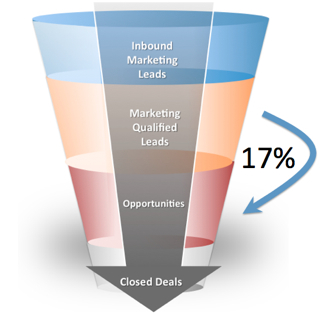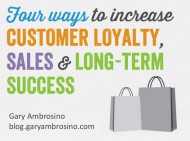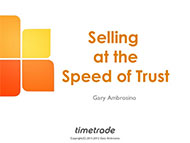In Part 1 we took a look at Inside Sales Cost (ISC) and the Lead Generation Effect – – the idea is that ISC keeps increasing as the number of leads you generate goes up as you hire more and more people to keep up with the growth – not a sustainable growth strategy.
Let’s take a closer look at ISC and the part of the funnel where Sales 2.0 organizations usually apply people resources. In this part of the funnel the goal is to convert Marketing Qualified Leads (MQL’s) into a sales Opportunity.
A GAME OF LOUSY ODDS
The conversion rate in this part of the funnel is about 17% on average – – that’s from Trish Bertuzzi, head of The Bridge Group, a leading inside sales strategy consulting firm.
A good yield for a business process ? Not quite. Not if you if you compare to the success rates of some other things you might do instead:
- Odds of getting to your destination in a car 99.99999999999999%+
- Odds of winning a well-played hand of blackjack 45%
- Odds of coming off your couch and summiting Mt. Everest 33%
- Odds an MQL will convert to an opportunity 17%
Think about this. A good portion of ISC (Inside Sales Cost) is spent on an activity that is 17% effective – – would it be better to take the sales budget and play blackjack for the same upside ?
THE CALLING, WAITING, CHASING GAME IS EXPENSIVE AND SLOW
What makes this part of the funnel expensive is the way inside sales are applied. Here’s a pretty typical follow-up for an inside sales team:

The economics of this calling, chasing, waiting sequence are pretty lousy. If you are a $20 million business with a $10K average selling price (ASP) using comparable funned yields (see Part 1) you need about 47,000 MQL’s. Playing the calling, waiting chasing game, at an average of $9 bucks an MQL , costs almost $500,000 just to quality prospects to the point you can hand them over the account reps. In a Sales 2.0 operation this takes about 10 people to accomplish over a 12 month period. The drawbacks to this whole exercise are pretty clear:
- Not Scalable – increase lead flow, you increase selling cost (see Part 1).
- No Automation – capacity to prospect is limited to available team time
- Low Velocity – the prospects control the rate of qualification
- Low Investment Return – waste 83% of your Inside Sales budget guaranteed.
CHANGE THE GAME – STOP CALLING, WAITING, CHASING
How about replacing the old-fashioned “four step” calling process using an entirely with some newer online tools that are perfect for engaging a prospect at the moment THEY are ready. Here are three that work well depending on your need:
 Chat is great for catching people on your web site and answering some questions. Not so great for sales qualifying. Requires having people on standby. www.liveperson.com
Chat is great for catching people on your web site and answering some questions. Not so great for sales qualifying. Requires having people on standby. www.liveperson.com
 Call Me is better qualifier than chat because it leads to a longer interaction. Ad-hoc so it’s not clear what the qualification level is. www.google.com
Call Me is better qualifier than chat because it leads to a longer interaction. Ad-hoc so it’s not clear what the qualification level is. www.google.com
 Click-to-Schedule is very good as an “ultimate opt-in” business tool – – especially when it’s key pivot-point in the sales process where you know the closing chances are pretty high – – like getting the prospect on the phone for a demo. When a prospect clicks this button, they are volunteering a committed, scheduled time, and they are ready to be sold to. Allows scheduling an inside or busineess development reps time from an “as available” pool and routes the appointments to the right person. www.timetrade.com
Click-to-Schedule is very good as an “ultimate opt-in” business tool – – especially when it’s key pivot-point in the sales process where you know the closing chances are pretty high – – like getting the prospect on the phone for a demo. When a prospect clicks this button, they are volunteering a committed, scheduled time, and they are ready to be sold to. Allows scheduling an inside or busineess development reps time from an “as available” pool and routes the appointments to the right person. www.timetrade.com
USING THESE INBOUND SALES TOOLS
For a lot of marketing and sales managers, these tools are not only new technology, but they also represent a new process – – one that can be counterintuitive if you are used to running a traditional inside sales process.
These tools, especially a “Schedule a 15 Minute Call”, put control into the customer’s hands as to when they want to engage. The job on the selling side of the equation is to equip your web site, outbound and inbound campaigns, and your social media presence with the content and remarkable information that brings someone to a point of trusted interaction.
In an upcoming post we’ll talk more about how to improve your prospecting yield through a trust-based interactive process.


